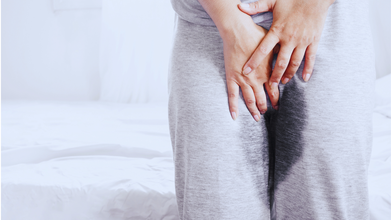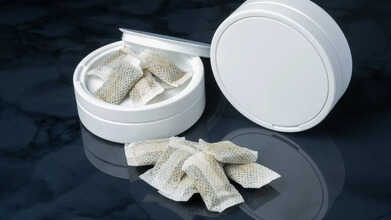- Health Conditions A-Z
- Health & Wellness
- Nutrition
- Fitness
- Health News
- Ayurveda
- Videos
- Medicine A-Z
- Parenting
Why Women Struggle With Urinary Incontinence And How Simple Exercises Can Help

Credits: Canva
You sneeze, and instead of a polite “bless you”, your bladder loses control. A laugh turns into a dribble. A cough? Well, tissues are not the only thing getting used. If this sounds familiar, you might be experiencing urinary incontinence. Nearly half of adult women go through it at some point. And while it is often whispered about in changing rooms or ignored altogether, it is a very real, very common problem.
What’s Actually Going On Down There?
Your bladder is not misbehaving for no reason. It is more like a balloon being held in place by a hammock of muscles called the pelvic floor. When that hammock loosens due to, say, pregnancy, childbirth, menopause, or years of constipation and coughing, the balloon slips, and leaks happen.
Some days it is a few drops; other days it feels like your bladder staged a prison break. Either way, it is exhausting and, for many women, embarrassing enough to change how they socialise, work out, or even laugh freely.
Alro Read: Why a Top Gut Doctor Says Bacon Should Be Banned from Breakfast Plates
The Silent Impact
Beyond the soggy underwear situation, incontinence messes with how women feel about themselves. You might skip that morning jog, pass on road trips, or avoid wearing light-coloured trousers. Some even avoid intimacy out of fear. It is not just physical; it can nibble away at your social life and mental health too.
But you do not have to live like this. Your bladder may be out of control, but it should not control you.
Exercises Your Bladder Wants You To Do
Now for the part nobody tells you: fighting leaks can actually be oddly simple. And no, you do not need a gym membership, expensive gadgets, or chanting over herbal teas. You just need a pillow and a few minutes a day.
The Pillow Squeeze
Take a cushion, wedge it between your knees, and squeeze like you are trying to pop it (but don’t). Hold, release, repeat 10–15 times. It looks silly, but your pelvic floor will thank you.The Invisible Lift (aka Isometric Hold)
Imagine you are trying to stop urine mid-stream. That is the move. Hold for five seconds, release, and repeat. Nobody around you will even know you are doing it, which makes it the perfect exercise for office Zoom calls.
Also Read: How 60 Grams of Almonds Daily Protects DNA and Beats Stress: Study
The Glute Bridge
Lie on your back, bend your knees, feet flat on the floor, then lift your hips towards the ceiling. It works your pelvic floor, strengthens your backside, and might even make your mirror smile back at you.
Lifestyle Hacks That Actually Help
Beyond exercises, a few tiny tweaks can make a big difference:
- Coffee and wine may be your emotional support beverages, but they irritate your bladder. Cutting down helps.
- Chugging litres of water at once? Not ideal. Sip slowly through the day.
- Carrying extra weight puts extra pressure on your bladder, so shedding a few kilos can ease things up.
- Try bladder training—go to the loo on a schedule and slowly stretch out the time between visits. Basically, teach your bladder some manners.
Why We Need To Talk About It
Almost nobody talks about urinary incontinence. Women put up with it in silence, hoping it will magically fix itself. It usually does not. Breaking the silence is half the cure. The more we normalise the conversation, the quicker we get to the solutions. Urinary incontinence is beatable. Strengthen your pelvic floor, tweak your habits, and stop pretending you have to just “live with it”. You are in charge here, not your bladder.Nicotine Pouches: Are They Really A Safer Alternative To Smoking, Or Just Another Health Risk?

Credits: Canva
The use of nicotine pouches is rising sharply across the UK, especially among young adults, recent research suggests. These small pouches sit between the lip and gum and release nicotine gradually into the body. Available in many flavours, they often include sweeteners and plant-based fibres. But are they truly a better option than smoking, or could nicotine pouches still pose health risks? We take a closer look below.
What Are Nicotine Pouches?
Nicotine pouches are small, tobacco-free sachets that contain nicotine powder along with flavourings and fillers. They are placed between the lip and gum, similar to snus, allowing nicotine to be absorbed without smoke, vapour, or spitting. Marketed as a discreet way to consume nicotine, they still deliver a highly addictive substance and expose users to certain chemicals. Health experts have raised concerns, particularly for young people, despite these products often being promoted as a “safer” choice than cigarettes.
Popular brands such as Zyn, On!, and Velo now dominate a fast-growing market, according to the CDC. Like vaping, they do not contain tobacco and are generally viewed as less harmful than smoking.
A recent study led by researchers at University College London (UCL) found that over the past five years, about 522,000 additional people in the UK have started using nicotine pouches, with usage rising from 0.1% to 1% of the adult population.
This has raised an important question: are nicotine pouches actually safer than smoking, and what is driving their sudden popularity?
Nicotine Pouches: Is Using Them Safer Than Smoking?
Speaking on *Mornings with Ridge and Frost*, lead study author Dr Harry Tattan-Birch from UCL’s Institute of Epidemiology and Health Care told Sky News that the risks linked to nicotine pouches are much lower than those associated with smoking. “There’s no tobacco and no combustion,” he explained. “And we know it’s the burning of tobacco that causes most smoking-related diseases.”
That said, Dr Tattan-Birch and his colleagues stressed that these products are not harmless and should never be accessible to children. The NHS notes that while nicotine itself does not cause serious diseases in the way tobacco does, young people’s developing brains and lungs are more vulnerable to its effects, and dependency can form quickly.
UCL research fellow Eve Taylor also told Sky News that nicotine pouches are “far less harmful than smoking,” but cautioned that they are still relatively new. Because of this, their long-term effects are not yet fully understood. “We can look at what’s in them to estimate potential risks,” she said. “They’re not risk-free. Users are still exposed to some toxic substances, even if the levels are much lower.”
Nicotine Pouches: Are Pouches Helping People Quit Smoking?
According to UCL’s findings, among participants surveyed between January 2022 and March 2025, 69% of nicotine pouch users were also using other nicotine products. More than half of them, 56%, were still smoking cigarettes. Around one in six users, or 16%, reported that they had never been regular smokers, suggesting the habit was not linked to quitting cigarettes.
As quoted by Sky News, Dr Tattan-Birch said the public health impact of nicotine pouches depends largely on who is using them. “If a young person who might otherwise smoke switches to pouches, that could reduce harm,” he said. “But if someone who wouldn’t have used nicotine at all starts using them, the risk of harm goes up.”
Researchers added that more studies are needed to understand whether nicotine pouches genuinely help people stop smoking in the long run.
Are Nicotine Patches Harmful For Health?
Nicotine patches are widely regarded as safer than smoking and are a well-established aid for quitting. They provide a steady dose of nicotine to reduce cravings without exposing users to tar or cancer-causing chemicals found in cigarettes. However, they are not completely without side effects. Common issues include skin irritation, headaches, and sleep disturbances. People with serious heart conditions or those who are pregnant are advised to speak with a doctor before using them, as nicotine can still affect heart rate and blood pressure, though far less dangerously than smoking, according to the CDC.
Is It Safe To Drink Alcohol On Ozempic? Doctors Say The Effects Can Be Stronger

Credits: Canva
Ozempic (semaglutide) has quickly become a widely used drug for managing type 2 diabetes and supporting weight loss. With its growing use, many people are wondering whether it has any interaction with alcohol. There have also been reports suggesting that Ozempic may reduce alcohol cravings in some users.
While it is not always necessary to completely avoid alcohol while taking Ozempic, doctors say there are certain side effects and risks that should not be ignored. To understand this better, we spoke with Dr Monika Sharma, Senior Consultant in Endocrinology at Aakash Healthcare.
Can Ozempic Make Alcohol Hit Twice as Hard?
Yes, alcohol can feel noticeably stronger when taken alongside medications like Ozempic, and this has a lot to do with how the drug alters digestion, metabolism, and brain signalling. Ozempic belongs to a class of medicines called GLP-1 receptor agonists. It is primarily prescribed for type 2 diabetes and is increasingly used for weight management. One of its key actions is slowing down stomach emptying, meaning that both food and liquids stay in the stomach longer before moving into the intestines.
Dr Sharma explains, “When alcohol is consumed, delayed gastric emptying can lead to uneven absorption. In some people, alcohol enters the bloodstream later but more rapidly once absorption begins, which can raise blood alcohol levels faster and intensify intoxication even with smaller amounts.”
Ozempic and Alcohol: Reduced Appetite and Drinking On An Empty Stomach
Another major factor is appetite suppression. Many people on Ozempic eat significantly less or skip meals altogether, either intentionally or due to reduced hunger. Drinking alcohol on an empty or nearly empty stomach allows it to be absorbed more quickly, as there is little food to slow the process. As a result, an amount of alcohol that once felt manageable may suddenly cause dizziness, flushing, nausea, or loss of coordination much sooner than expected.
Ozempic and Alcohol: Brain Effects and Alcohol Sensitivity
Ozempic also affects areas of the brain linked to reward, fullness, and impulse control. Emerging research suggests that GLP-1 receptor agonists may lower cravings for substances like alcohol, while at the same time increasing sensitivity to its effects. This means that even if the desire to drink decreases, the body’s reaction to alcohol may feel stronger or more unpleasant. Many users report unusual tiredness, light headedness, or nausea after just one drink, often describing it as alcohol “hitting twice as hard.”
Ozempic and Alcohol: Blood Sugar Changes and Hypoglycemia Risk
Blood sugar regulation is another concern. Alcohol can cause fluctuations in glucose levels, and when combined with a medication that tightly controls insulin release and glucose use, the risk of low blood sugar increases, particularly for people with diabetes. Symptoms of hypoglycemia include sweating, shaking, confusion, and palpitations. These signs can resemble alcohol intoxication or worsen its effects, making the experience more intense and potentially dangerous.
Ozempic and Alcohol: Dehydration and Slower Recovery
Dehydration also plays a role. Ozempic can cause side effects such as nausea, vomiting, and reduced fluid intake, all of which increase the risk of dehydration. Alcohol further depletes fluids, and when the body is already low on hydration, alcohol’s impact on the brain and heart becomes stronger. This can lead to faster intoxication, headaches, and a longer recovery time after drinking.
Ozempic and Alcohol: Gut Sensitivity and Worsening Side Effects
Gastrointestinal sensitivity should also be considered. Ozempic commonly causes nausea, bloating, acid reflux, and stomach discomfort, especially in the early months of treatment. Alcohol irritates the stomach lining and relaxes the lower oesophageal sphincter, which can worsen these symptoms. Together, even small amounts of alcohol can trigger stronger negative reactions, reinforcing the feeling that tolerance has suddenly dropped.
Why Alcohol Feels Stronger On Ozempic
While Ozempic does not directly interact with alcohol the way some medications do, its indirect effects on digestion, hydration, metabolism, and the nervous system can make alcohol feel more potent. This is why moderation is strongly advised. People taking Ozempic should limit alcohol intake, avoid drinking on an empty stomach, stay well hydrated, and pay close attention to how their body responds.
In short, Ozempic can make alcohol feel stronger not because it increases alcohol levels directly, but because it changes how the body processes and reacts to alcohol. Being aware of this interaction can help people make safer, more informed choices while using this medication.
Indoor Air In Delhi Is More Toxic Than Outdoor Smog, Pulmonologist Warns

Credits: Canva
Dense, toxic smog covered India’s capital on Monday, driving air pollution to its highest levels in weeks, disrupting travel, and prompting authorities to enforce the strictest containment measures. More than 40 flights were cancelled, with several dozen more delayed. Over 50 trains arriving and departing from New Delhi faced delays of several hours, officials reported. Healthcare experts urged residents to stay indoors as hospitals recorded a surge in patients with breathing problems and irritated eyes. Now, a pulmonologist is warning that indoor air in Delhi might actually be more hazardous than the smog outdoors.
Delhi Pollution: Indoor Air More Toxic Than Outdoor Smog
Indoor air quality in Delhi is reportedly worse than the air outside, according to a lung specialist. Dr. Vivek Nangia, head of pulmonology at Max Healthcare, said indoor spaces can have particulate matter, or PM2.5 levels, nearly two-and-a-half times higher than outdoor readings, even when there are no direct pollution sources indoors.
“Indoor air can be 20 to 30 times more polluted than outdoor air, so it’s important to monitor and improve it,” he explained. Studies have shown that lung-damaging tiny particles inside homes are “substantially higher” than what nearby government monitors report outdoors. This was also confirmed by a study conducted by the Energy Policy Institute at the University of Chicago (EPIC) between 2018 and 2020, which surveyed thousands of Delhi households across different income levels, finding that both rich and poor families are affected equally.
Researchers noted that wealthier households were 13 times more likely to own air purifiers than low-income ones, yet indoor pollution in those homes was only about 10% lower than in disadvantaged settings.
“In Delhi, the bottom line is—whether someone is rich or poor, nobody gets to breathe clean air,” said Dr. Kenneth Lee, the study’s lead author. “It’s a complex, vicious cycle.”
How Does Indoor Air Quality Affect Your Lungs?
Poor indoor air quality (IAQ) can harm the lungs by causing inflammation, weakening the body’s defenses, and triggering or worsening conditions such as asthma and COPD. Pollutants like dust, mold, VOCs, and smoke can lead to coughing, wheezing, infections, and long-term lung damage, even raising the risk of lung cancer over time. Because the lungs are constantly exposed to air, they are extremely sensitive to irritants, which can reduce lung function and capacity—particularly in children, older adults, and those with pre-existing conditions, according to the American Lung Association.
Dr. Nangia noted that patients are now showing a different kind of chest congestion. “These days we’re seeing two kinds of patients—those who never had lung issues before but are now coming in, saying their coughs, sneezing, and chest congestion started once air quality worsened, and those with existing lung problems who are experiencing much worse symptoms,” he said.
How To Protect Yourself From Indoor Toxic Air?
According to the American Lung Association, protecting yourself from indoor air pollution involves controlling sources of pollutants (no smoking, using low-VOC products), improving ventilation (opening windows, using exhaust fans), using HEPA air purifiers, cleaning regularly (dusting and vacuuming), managing humidity to prevent mold, and wearing N95 masks on days with high outdoor pollution to reduce indoor air infiltration.
© 2024 Bennett, Coleman & Company Limited

